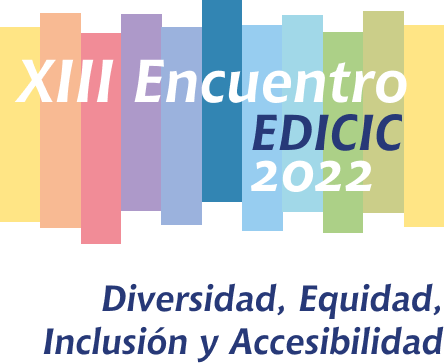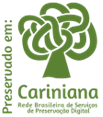“nothing about us without us”: assistive technology and user studies of visually impaired people in university libraries
DOI:
https://doi.org/10.62758/re.v2i4.141Keywords:
User Study, Assistive Technology, People with Visual Impairments, University Library, AccessibilityAbstract
The creation of international legislation in order to ensure the rights of people with disabilities had repercussions on the development of laws, ordinances, decrees and other legal instruments at the national level in several countries. Although there is a history of legislation in favor of people with disabilities, the social inclusion of this group was delayed in several countries, especially in the educational sphere. The issue of accessibility, in the planning of libraries, with emphasis on university students, is often not considered in this initial phase, being only thought of when a person with a disability seeks face-to-face service. In this direction, the functions of Assistive Technology resources are added as methodologies, instruments or equipment to mediate access to information for users with visual impairments and their contribution to making the university library truly an inclusive space. However, the existence of several determining factors, including the presence of architectural, attitudinal and informational barriers, widen the distance between libraries and people with visual impairments or establish a superficial bond, in which products and services are emphasized, while user needs are often not consulted and are rarely addressed. This study aimed to identify, in the literature of user studies, the perceptions of people with visual impairments about the Assistive Technology resources present in university libraries. As a theoretical framework, aspects related to the historical path of attempts to include people with disabilities in society, the importance of Assistive Technology resources, with emphasis on university libraries, for the accessibility and social inclusion of people with disabilities in higher education and the user studies as a way of evaluating the satisfaction of the visually impaired person in relation to the use of Assistive Technology resources in university libraries. As methodological procedures, a literature review was carried out in five databases: Reference Databases of Articles in Information Science, Scientifc Electronic Library Online, Brazilian Portal of Open Access Scientific Publications and Data, Scopus and Web of Science, in which articles and reference articles that addressed the researched topic were selected. As a result, it was found that studies of users of people with visual impairments in university libraries are still scarce and that the Assistive Technology resources present in these spaces do not always contemplate the informational needs of this public. It is considered the need to carry out more in-depth future studies with people with visual impairments, reinforcing and fulfilling the motto “Nothing about us without us” and making them protagonists so that they are, in fact, benefited and included in the information society.
References
Associação Brasileira de Normas Técnicas (2020). NBR 9050/2020: acessibilidade a edificações, mobiliário, espaços e equipamentos urbanos. Associação Brasileira de Normas Técnicas.
Acessibilidade e Inclusão – UFMG. Modelo de deficiência e funcionalidade. (2020, Outubro 22). [Vídeo]. Youtube. https://www.youtube.com/watch?v=ML7C7NJ6MjE&t=1103s.
Amorim, M. L. C. (2006). Construção e adaptação de um teste de atenção para indivíduos com deficiência visual: estudo baseado no Teste de Atenção de Bams. [Dissertação de Mestrado na Universidade do Porto]. Universidade do Porto. https://repositorio- aberto.up.pt/bitstream/10216/14112/2/22593.pdf.
Agabirwe, P. & Kiyingi, G. W. (2020, March 23-26). Utilization of assistive technologies among visually impaired students in university libraries in Uganda: Users’ Experiences. [Conference session]. Sustainable Digital Communities. Boras, Suécia. 470–479. DOI: https://doi.org/10.1007/978-3-030-43687-2_37
Aoyama, P. (2011). Estudo das necessidades de informação dos usuários da Biblioteca Digital do Senado Federal. [Monografia de Graduação em Biblioteconomia]. Faculdade de Ciências da Informação, Universidade de Brasília.
Aranha, M. S. F. (2005). Projeto Escola Viva: garantindo o acesso e permanência de todos os alunos na escola: necessidades educacionais especiais dos alunos. 2 ed. Brasília: Ministério da Educação, Secretaria de Educação Especial.
Araújo, C. A. A. (2010). Abordagem interacionista de estudos de usuários da informação. Ponto de Acesso, 4(2), 2-32. DOI: https://doi.org/10.9771/1981-6766rpa.v4i2.3856
Asebriy Z., Raghay, S. & Bencharef, O. (2018). An assistive technology for braille users to support mathematical learning: a semantic retrieval system. Symmetry, 10(11), 1-16. https://doi.org/10.3390/sym10110547. DOI: https://doi.org/10.3390/sym10110547
Baptista, S. G. & Cunha, M. B. (2007). Estudo de usuários: visão global dos métodos das coletas de dados. Perspectivas em Ciência da Informação, 12(2), 168-184. DOI: https://doi.org/10.1590/S1413-99362007000200011
Bardwaj, R. K. (2018). Information access mechanism for visually impaired students in higher educational institutions: a study. Journal of Library & Information Technology, 38(6), 387-395. DOI: 10.14429/djlit.38.6.13603 DOI: https://doi.org/10.14429/djlit.38.6.13603
Bersch, R. (2008). Introdução às tecnologias assistivas. http://www.assistiva.com.br/Introducao_Tecnologia_Assistiva.pdf.
Chaurasia, A. & Singh, A. P. (2022). Assistive Support through technologies for persons with disabilities in libraries. Journal of Library & Information Technology, 42(2), 130-135. DOI: 10.14429/djlit.42.2.17558. DOI: https://doi.org/10.14429/djlit.42.2.17558
Chen, Q. (2014). Applied-information technology in barrier-free service of university library. Advanced Materials Research, 1021, 257-260. https://doi.org/10.4028/www.scientific.net/AMR.1021.257. DOI: https://doi.org/10.4028/www.scientific.net/AMR.1021.257
Coneglian, A. L. O. & Casarin, H. C. S. (2014). Deficientes como usuários de informação. In: Casarin, H. C. S. (Org.). Estudos de usuário da informação. Marília: Oficina Universitária. (pp. 220-254).
Corrêa, M. A. M. (2005). Educação especial: v.01. Fundação CECIERJ. https://canalcederj.cecierj.edu.br/012016/a1af164aed3aff470abbd469102d4a12.pdf.
Cunha, M. B. (1982). Metodologias para estudos de usuários de informação científica e tecnológica. Revista de Biblioteconomia de Brasília, 10(2), 5-20.
Cunha, M. B.; Amaral, S. A.; Dantas, E. B. (2015). Manual de estudo de usuários da informação. Atlas.
Dias, M. M. K. & Pires, D. (2004). Usos e usuários da informação. São Carlos: Edufscar.
Dodamani, A. M. & Dodamani, S. M. (2019). Provision of assistive technology for students with visual impairment in university libraries in India. Journal of Library & Information Technology, 39(3), 104-108. DOI: 10.14429/djlit.39.3.14329. DOI: https://doi.org/10.14429/djlit.39.3.14329
Ferreira, K. L. C., Dias, A. C. B., Freitas, M. K. S., Farias, K. A. & Brasil, E. C. A. (2019, Outubro 1-4). Análise de medidas acessíveis na Biblioteca Universitária da UFC Campus Quixadá. Congresso Brasileiro de Biblioteconomia e Documentação, Vitória, ES, Brasil. https://repositorio.ufc.br/bitstream/riufc/49136/1/2019_resumo_klcferreira.pdf.
Figueiredo, N. M. (1983). Aspectos especiais de estudos de usuários. Ci. Inf., 12(2), 43-57.
Fundação Dorina Nowill (2022). https://fundacaodorina.org.br/a-fundacao/pessoas-cegas-e-com-baixa-visao/estatisticas-da-deficiencia-visual/.
Gil, M. (Org.) (2000). Deficiência visual. Secretaria de Educação a Distância. http://portal.mec.gov.br/seed/arquivos/pdf/deficienciavisual.pdf.
Instituto Brasileiro de Geografia e Estatística (2010). Censo 2010. https://www.ibge.gov.b/estatisticas-novoportal/sociais/educacao/9662-censo-demografico- 2010.html?edicao=9749&t=destaques.
Kumar, S.; Sanaman, G. (2013). Web challenges faced by blind and vision impaired users in libraries of Delhi. The Electronic Library, 33(2), 242-257. DOI: https://doi.org/10.1108/EL-03-2013-0043
Masini, E. F. S. (1994). O perceber e o relacionar-se do deficiente visual: orientando professores especializados. Coordenação Nacional de Integração de Pessoa Portadora de Deficiência.
Melo, A. M., Costa, J. B. & Soares, S. C. M. (2006) Tecnologias assistivas. In: Pupo, D. T., Melo, A. M. & Ferrés, S. P. (Orgs.). Acessibilidade: discurso e prática no cotidiano das bibliotecas . Campinas: Unicamp. (pp. 62-70).
Merizio, T. M. P. (1999). Necessidades informacionais dos deficientes visuais do CEAD. [Trabalho de Conclusão de Curso de Graduação em Biblioteconomia]. Universidade Estadual de Londrina.
Mutula S. & Majinge R. M. (2016). Information behavior of students living with visual impairments in university libraries: a review of related literature. The Journal of Academic Librarianship, 42(2016), 522-528. http://dx.doi.org/10.1016/j.acalib.2016.06.019 0. DOI: https://doi.org/10.1016/j.acalib.2016.06.019
Oliveira, M. (Coord.) (2011). Ciência da Informação e Biblioteconomia: novos conteúdos e espaços de atuação. (2.ed.) Belo Horizonte: UFMG.
Organização Mundial de Saúde (2011). https://nacoesunidas.org/acao/pessoas-com-deficiencia/.
Pelosi, M. B. (2006). Por uma escola que ensine e não apenas acolha recursos e estratégias para a inclusão escolar. In: Manzini, E. J. Inclusão e acessibilidade. ABPEE. (pp. 121- 132).
Pinheiro, A. C. (2021). Os recursos de Tecnologia Assistiva nas bibliotecas universitárias federais brasileiras: uma abordagem para as pessoas com deficiências visuais. [Dissertação de mestrado em Ciência da Informação]. Universidade Federal de Minas Gerais.
Rodrigues, P. R. & Alves, L. R. (2013).Tecnologia assistiva: uma revisão do tema. Holos, (6)29, 170-180. https://doi.org/10.15628/holos.2013.1595. DOI: https://doi.org/10.15628/holos.2013.1595
Santos, K. G. & Carvalho, K. A. (2019). Acessibilidade e tecnologia assistiva em bibliotecas universitárias: estudo de caso no Centro Federal de Educação Tecnológica de Minas Gerais. Revista Ibero-Americana de Ciência da Informação, 13(1), 5-19. https://doi.org/10.26512/rici.v13.n1.2020.22362. DOI: https://doi.org/10.26512/rici.v13.n1.2020.22362
Sassaki, R. K. (2006). Inclusão: construindo uma sociedade para todos. WVA.
Saracevic, T. (1997). Users lost: reflections on the past, future, andlimits of information science. ACM SIGIR Forum, 31(2), 16-27. DOI: https://doi.org/10.1145/270886.270889
Sawyer, S. & Huang, H. (2007). Conceptualizing information, technology, and people: comparing information science and information systems literatures. Journal of the American Society for Information Science and Technology, 58(10), 1436-1447. https://doi.org/10.1002/asi.20621. DOI: https://doi.org/10.1002/asi.20621
Souza, O. & Tabosa, H. R. (2018). Estudo sobre a contribuição da Ciência da Informação em pesquisas sobre Tecnologias Assistivas. Comunicação & Informação, 21(1), 70-88. DOI: https://doi.org/10.5216/ci.v21i1.45987
Universidade Aberta do SUS da Universidade Federal do Maranhão (2019, Outubro 22). Modelo biomédico e biopsicossocial da deficiência. [Vídeo]. Youtube. https://www.youtube.com/watch?v=tPq9FaYxY6k.
Wellichan. D. S. P., Lino, C. C. T. S. & Manzini E. J. (2021). Biblioteca na vida acadêmica de um estudante surdo: um relato de experiência. InCID: R. Ci. Inf. e Doc, 12(2), 284-304. DOI: 10.11606/issn.2178-2075.v12i2p284-304. DOI: https://doi.org/10.11606/issn.2178-2075.v12i2p284-304
Wellichan, D. S. P. & Manzini, E. J. (2018). A Tecnologia Assistiva em bibliotecas públicas: uma abordagem preliminar sobre sua importância e contribuição para usuários com deficiência. Biblionline, 14(4), 83-90. DOI: https://doi.org/10.22478/ufpb.1809-4775.2018v14n4.42021. DOI: https://doi.org/10.22478/ufpb.1809-4775.2018v14n4.42021
Wellichan, D. S. P. & Manzini, E. J. (2021). Usuários da informação com deficiência em bibliotecas: uma análise da produção científica em Biblioteconomia e Ciência da Informação. Em Questão, 27(3), 172-203. DOI: https://doi.org/10.19132/1808-5245273.172-203. DOI: https://doi.org/10.19132/1808-5245273.172-203
Downloads
Published
How to Cite
Issue
Section
License
Copyright (c) 2022 Revista EDICIC

This work is licensed under a Creative Commons Attribution 4.0 International License.
The Association holds the copyright of the texts it publishes and, therefore, adopts a Creative Commons License, CC BY 4.0 DEED Attribution 4.0 International (https://creativecommons.org/
You are free to:
- Share: copy and redistribute the material in any medium or format for any purpose, even commercially.
- Adapt: remix, transform, and build upon the material for any purpose, even commercially.






